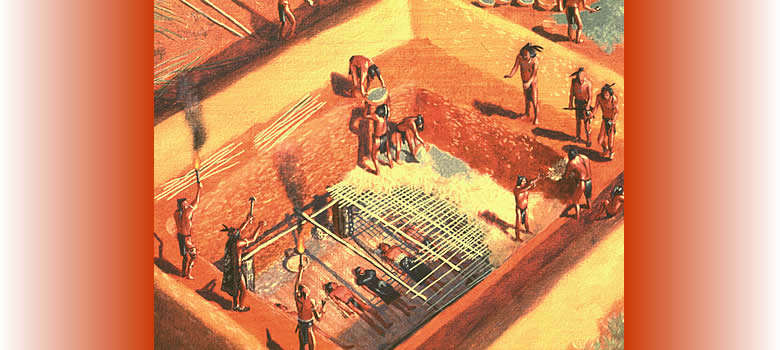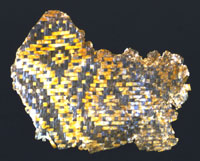
Woven mat fragment with bird design
found in a large Early Caddo tomb at the Mound Plantation
site along the Red River in northwest Louisiana. The
mat fragment was preserved only because the tomb was
waterlogged. According to early chroniclers, the Caddo
were famous for their woven mats. Deceased individuals
were often laid to rest on such mats. Courtesy Pictures
of Record.
|
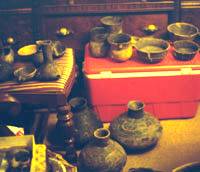
Small part of the collection of a
notorious grave robber who dug up hundreds of Caddo
graves in northeast Texas. Following his death, the
looted grave offerings were sold to private collectors.
Photo from TARL archives.
|
| Caddo
ancestors were laid to rest within the Caddo Homeland
for generation upon generation. Following the accepted
burial custom of the day, grieving relatives laid each
departed Caddo in his or her grave with solemn rituals
that, in historic times, traditionally lasted six days, during the journey of the deceased to the House of the Dead in the Sky.
|
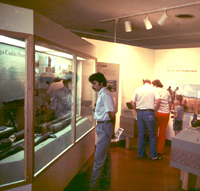
The interpretive displays at Caddo
Mounds State Historic Site (George C. Davis archeological
site) allow the public to see artifacts from graves
in context with information about many aspects of ancient
Caddo society. Courtesy Texas Parks and Wildlife Department.
|
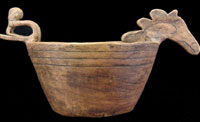
This replica "tail-rider"
bowl was made by Caddo tribal member Jerri Redcorn based
on the original found in a grave at the Battle site
in 1912. Redcorn has almost single-handedly revived
the Caddo ceramic tradition and uses ancient Caddo pottery
as sources of knowledge. Bowl courtesy Tim Perttula.
Photograph by Sharon Mitchell.
|
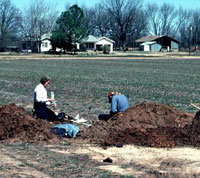
Archeologists document a recently looted grave in early 1980s at the Hatchel site (part of Upper Nasoni village) on the Red River near Texarkana. The uncontrolled digging apparently had been done with the permission of the landowner. (The present landowner of this site does not allow grave robbing.) Photo courtesy Texas Historical Commission.
|
|
Caddo ancestors were laid to rest within the
Caddo Homeland for generation upon generation. Following the
accepted burial custom of the day, grieving relatives laid
each departed Caddo in his or her grave with solemn rituals
that, in historic times, traditionally lasted six days,during the journey of the deceased to the House of the Dead in the Sky. Often
the custom included burying the dead with special artifacts
or offerings, especially beautifully decorated pottery vessels,
but also with shell ornaments and other items symbolizing
their role in society and other things as well. Since Late
Woodland times, over 1200 years ago, Caddo people were buried
soon after death in a manner that archeologists describe as
primary interments. Typically, the deceased were laid out
on their backs in a fully extended position, a single individual
in each grave. In contrast, in many areas of the Eastern United
States (including the Arkansas Basin) the deceased were placed
in charnel houses where priests defleshed
the bones and stored them for months or even years. In such
societies, the stored remains were periodically gathered and
buried in ossuaries, large communal graves, as secondary interments,
as part of communal rituals. Craig Mound at Spiro is an extraordinary
example of a complex mortuary facility.
In prehistoric and early
historic times, the offerings and burial rituals for important
Caddo leaders were very elaborate, representing major expenditures
of effort and wealth apparently thought to befit the leader's
exalted position in society. Sometimes leaders were buried
in deep tombs dug through mounds and into the original earth,
perhaps symbolically connecting sacred times past with the
departed. At other times leaders were buried among their people,
but even then their graves were set apart by size, location,
and offerings. Ordinary Caddos had less elaborate graves and
were often buried in family cemeteries and sometimes (especially
children) buried beneath the floors of their houses. These
differences are just a few of those that could be mentioned;
Caddo burial practices were somewhat different from group
to group and they changed over time.
We know this because grave
robbers, farmers, archeologists, and construction bulldozers
have been digging up Caddo graves for over a century, a fact
that causes great pain to many Caddo people today. If
it were the graves of your ancestors that were subject to this distruction, you would understand
how the Caddo feel: violated, disrespected, and very sad.
There is no easy way to explain what has happened or why and
no way to reconcile all the conflicting views on the subject
of Caddo graves.
Since the early 1900s archeologists
have sought out and excavated Caddo graves, most of which
faced imminent destruction by looters, farming, and natural
erosion. The graves, skeletal remains, and associated offerings
have provided critical knowledge about the Caddo past. For
example, information on social organization, health, and disease
based on Caddo graves is not otherwise obtainable from archeological
evidence. The way a society treats its dead says much about
that society, and clearly there is no other comparable source
of information for prehistoric societies. In addition, physical
remains are practically the only source of information on
individual lives of ancestral Caddo people, as well as on the
biological relationships among individuals and populations.
Unfortunately, for many decades archeologists
treated Caddo graves with little awareness of the feelings
of living Caddo peoples. Taking a Western scientific perspective,
archeologists regarded human remains and grave offerings as
mere evidence, perhaps important evidence, but evidence nonetheless.
In this view, the remains are considered dispassionately and
treated like any other fragile and potentially important kind
of artifact. With that attitude, most archeologists had no
interaction with the Caddo Nation because they really did not appreciate
the connection between the ancient Caddo and the living
Caddo.
Part of the problem was that, by the 20th century,
very few Caddo people lived in the Caddo Homeland where archeologists
were working. Unfortunately, the thought that Caddo people
living in west-central Oklahoma might still care about the
graves of their distant ancestors was just not there. To be
fair, to most archeologists the concept of "ancestors,"
as seen through western eyes, refers mainly to relatives a
family still retains memory or record of. They did not realize that in Native American eyes, ancestors of the recent
past are thought of in much the same way as ancestors of the
ancient past. This attitude was not unique to the archeologists
who worked in the Caddo area—it was widely shared by
most American archeologists. American archeologists came to
believe that many aspects of prehistoric North American were
essentially unconnected to modern tribes—too much time
and too many changes had occurred; cultural continuity had
been lost.
Archeologists saw themselves as the only ones
truly interested in the prehistory of North America and thought
that archeology was the only thing standing between ignorance
of the past and willful grave destruction. As enlightened
scientists, archeologists sincerely believed they were working
against the inevitable march of progress and against the "dark
side"—grave robbers and land development.
In truth, most people who dig up Caddo graves
are not archeologists; they are artifact collectors intent
on finding valuable things, most of all, whole pottery vessels and other funerary offerings. They
are usually called pothunters, looters, or grave robbers.
Some do have an interest in documenting what they find and
consider themselves "amateur archeologists," but
most dig up graves solely to find grave offerings. Most dig
without regard to whatever human remains they find and keep
little or no record. As a group, grave robbers are highly
secretive and rarely publish descriptions of their work and
findings. Some want the artifacts just for their own personal
collections, but increasingly the motive is greed. An intact,
finely engraved Caddo pottery vessel can bring thousands of dollars on
the antiquities market. Untold hundreds of Caddo graves have been dug up every year in this manner, at least an order of magnitude
more than the number of graves that archeologists excavate.
Today, archeologists rarely excavate Caddo graves
except in circumstances required by federal and state cultural
resource laws and/or occasioned by emergency salvage. When
archeologists encounter Caddo graves during the course of
cultural resource management projects, they routinely consult
with the Caddo Nation of Oklahoma. In contrast, grave robbing
continues apace and slows only because so many cemeteries
have already been destroyed. Still, many Caddo graves
are dug up each year by those hunting Caddo pots. Grave robbers
often trespass on private, state, or federal lands and dig
up graves surreptitiously and illegally.
Arkansas, Oklahoma, Louisiana, and Texas all have laws affording some legal protection to "unmarked graves." In Texas, these legal protections fall under the recently amended Health and Safety Code of Texas and the Texas Administrative Code. Today, most professional archeologists in Texas do hold the view that human graves, marked or unmarked, Indian or Anglo-American, historic or prehistoric, Christian or non-Christian, should be protected by law and left unmolested except when unavoidable or with particularly good cause, such as a significant research question that can only be answered by studying graves. In such cases archeologists should work with descendant communities to reach an equitable compromise between scientific and humanistic concerns. Such a compromise is not always possible.
While all Caddo people may not have the same
attitude toward the graves of their ancestors, most believe
the resting places of their ancestors are sacred and should be left undisturbed
out of respect for their memory. One of the most remarkable
things about ancestral Caddo cemeteries is that one grave rarely
intrudes into another, even in cases where the burials were
separated in time by decades or even centuries. Given the
complete absence of headstones or other durable markers, the
graves must have been marked by perishable materials, likely marker poles, that
were periodically renewed. This shows that Caddo cemeteries,
like most cemeteries in the United States today, were created
as permanent resting places that were cared for by succeeding
generations. Given this tradition, it is easy to understand
why some Caddo see grave robbing as grave robbing whether
it be done in the name of science, curiosity, or commerce.
Other Caddo see a difference and acknowledge that archeologists
have learned many things about Caddo ancestors that had been
lost. Much of the content of the Tejas exhibit you are reading
comes from archeological research.
For their part, most archeologists today realize
that science is only one perspective and that Caddo peoples
have every right to play a major role in deciding what should
happen to Caddo skeletal remains, graves, and grave offerings.
Most of the change in attitude came about after the passage
of the Native American Graves Protection and Repatriation
Act (NAGPRA). This federal law enacted in 1990 is really a
civil rights law that has had profound consequences for the
Caddo and other federally recognized Indian tribes. Essentially
NAGPRA says that human graves on federal and tribal lands
are to be protected. It also says that Native American descendants
should decide the fate of the skeletal remains, grave offerings,
and sacred objects of their ancestors that are encountered
by the federal government and held by any institution, such
as a museum, that receives federal funding. NAGPRA requires
federal agencies that administer or carry out archeological
research on federal or tribal lands to consult with the appropriate
tribes in advance of work that might disturb graves associated
with their ancestors.
The result has been that, for the first time,
the Caddo tribe has been given a say-so in what happens when
Caddo graves are encountered that fall under NAGPRA regulations.
The Caddo tribe also has the right to decide what happens
to the Caddo skeletal remains and grave offerings in museums
and repositories across the country. As a consequence, constructive
dialogues have taken place in recent years between the tribe and all of the major
agencies and organizations that are involved in archeology
in the Caddo Homeland.
NAGPRA attempts to balance the legitimate interests
of Native Americans and scientists. While the intent of the
law is clear and reasonable, the enabling regulations have
created a tedious and contentious process that sometimes pits
Native Americans against archeologists, oral tradition against
science, and one tribe against another. For instance, who
should decide the fate of the many skeletal remains and grave
offerings that cannot be definitively affiliated to a living tribe?
What happens when two tribes both claim the same grave? How
about when a scientist proposes to use destructive analytical
methods in order to determine which, if any, living tribe
can be linked to those skeletal remains?
Fortunately, things have gone relatively smoothly in the Caddo Homeland in comparison to many other places in the country. For one thing the Caddo Homeland and the archeological sites within it is well known and there are few disputes about whether a grave is associated with the tribe or not. Still, there are many issues that remain to be resolved. For instance, the Caddo Nation has not made a final decision regarding what to do with all the Caddo skeletal remains and grave offerings in museums and repositories, although they have established a reburial cemetery on their tribal land. Some say "rebury them all," but how and where? Who will pay for proper burials for so many things? Others recognize that the thousands of Caddo pottery vessels sitting on shelves represent a tremendous cultural legacy. In many cases the skeletal remains the pottery vessels once accompanied have not survived (mainly due to acidic soil conditions). Should all these objects be buried again and, in essence, removed from visible Caddo history? Some say that Caddo pottery vessels and other grave offerings should be returned to the tribe and sensitively displayed in a museum run by the Caddo. But building and running a museum takes lots of money and training. The tribe has taken positive steps in this direction with the creation of the Caddo Heritage Museum and its own Tribal Historic Preservation Office. In the end, under NAGPRA, the Caddo Nation of Oklahoma makes the final decisions on the repatriation and reburial of human remains and funerary offerings affiliated to them.
|
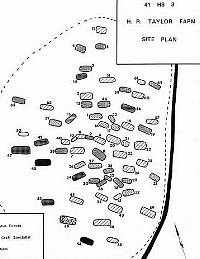
Plan of a Late Caddo community cemetery
(about A.D. 1600-1700) at the Taylor Farms site near
Lake O' the Pines within the valley of Big Cypress Creek
in northeast Texas. The University of Texas excavated
this site in 1931 and documented 64 graves. Note the
fairly consistent east-west grave orientation and the
fact that the graves do not intrude into one another.
Click images to enlarge
|
| In truth, most people
who dig up Caddo graves are not archeologists; they are
artifact collectors intent on finding valuable things,
most of all, whole pottery vessels and other funerary offerings. They are usually called pothunters,
looters, or grave robbers. |
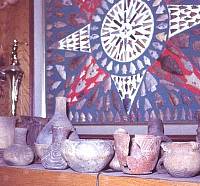
Caddo grave offerings displayed as
trophies in the home of a notorious grave robber. Photo
in TARL archives.
|
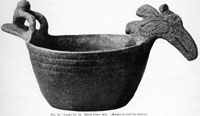
This unusual "tail-rider"
bowl was found in a grave at the Battle site near the
Red River in southwest Arkansas in 1912 by C. B. Moore.
Such vessels resemble those found in the Mississippi
valley in northeast Arkansas and represent connections
between the two areas in Late Caddo times.
|
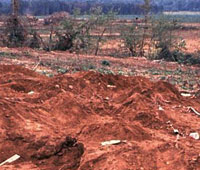
This Late Caddo cemetery in northeast
Texas was destroyed by looters in search of whole pottery
vessels. Broken pots and human skeletal remains were
left behind in the churned up mess.
|
| While
all Caddo people may not have the same attitude toward
the graves of their ancestors, most that we know do. They
believe the resting places of their ancestors should be
left undisturbed out of respect for their memory. |
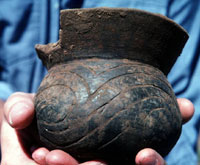
Small, Late Caddo jar excavated from
a grave by the couple shown in picture on the left at
the Hatchel site on Red River near Texarkana. Photo
courtesy Texas Historical Commission.
|
|
